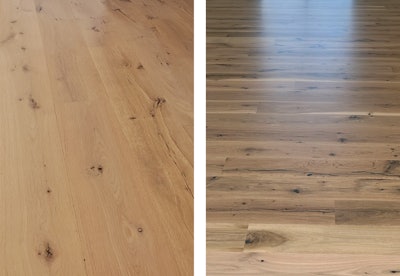
The other day I saw a job that was described to me as “NOFMA select” walnut plank. There was not a piece of walnut in that floor that was longer than 3 feet; there were boards that were barely twice as long as they were wide in this floor. (Who even sells that?!) Obviously some manufacturer had taken a low grade of lumber, cut all the knots out and made select walnut flooring out of it. This is just one example of an issue that I see happening constantly: ordering the same NOFMA-grade product from different companies and receiving product that does not meet your expectations. When you’re doing high-end work, you are often looking for specific qualities in the flooring that go way beyond the basic grade.
In general, I see many manufacturers pushing grade right now, and by that I mean they are trying hard to maximize yields from their lumber, and sometimes buying lower-grade lumber and defecting it to make flooring, which results in a lot of short lengths. You have to be proactive when you’re buying your flooring to figure out how to get the look you and your clients want. Here are some things to find out more about:
Average lengths: One manufacturer might say they have 1- to 8-foot nested bundles, but there are two boards that are 8 feet and the rest of them are 1 to 3 feet long. I have a supplier that offers character walnut in 1- to 10-foot lengths, with an average length of 6 feet. I might pay the same price to another supplier and get an average length of 3½ feet. So the critical question is: What is the average length for each bundle of flooring? Just knowing the shortest and longest length does not give you enough information.
Starting lumber grade: It can often be helpful to determine the National Hardwood Lumber Association grades that will be included in your floor. These grades are different from NOFMA and can give you a better insight as to what your floor product will look like. If you are buying select plainsawn 7-inch plank and the flooring mill is using #2 common and better lumber to produce that floor, then you can pretty much be sure they will be cutting out a large number of knots and your floor will be fairly short. I do not mind a 1- to 10-foot floor that starts with NHLA-graded 35% #2 common, 35% #1 common and the balance select and better of FAS. This will be a long-average-length floor. Even better would be 50% #1 common lumber and 50% FAS that would yield an average length of 7 or more feet in a 1- to 10-foot select-and-better. Know what your mill is using, and you can get a strong feel for what your end product will look like. I have one mill that will quote a 4- to 12-foot select walnut and I will state that the price is too high for this customer. They will then tell me they can average the floor cost down by using more #2 common in production. This can be an option to meet a price point for your customer, but you need a clear understanding of what it will produce.
Knots: How many are there? What is the biggest open knot allowed? In my character flooring, I don’t mind a star knot, which is when the knot pulls apart in a star pattern as the wood dries. Star knots look good when you fill them. But for a fall-out knot, where it’s just a round or oblong hole, I don’t want any that are bigger than a half inch, because I don’t like how they look filled. Some mills sort between star knots and fall-out knots really well, and some don’t.
 At left, a filled fall-out knot. At right, a filled star knot.
At left, a filled fall-out knot. At right, a filled star knot.
Color and amount of sap: We all know there can be huge variations in color from the same species. Northern walnut doesn’t have as much color as Southern walnut. Northern walnut also has smaller knots, less sap and a lighter color tone. But are you staining the floor? Does the lighter color matter? You have to be thoughtful about what actually matters for each specific project.
Growth rings per inch: I can buy “character” white oak from one manufacturer and it has lots of big open knots and nine growth rings per inch. I can buy “character” white oak from another manufacturer and it has fewer knots, smaller knots and growth rings so close together it looks like reclaimed lumber. It’s obvious which one I want to buy! Select-and-better long-length white oak from one mill and growth region to another can be profoundly different in grain structure. I used to think that French oak was way nicer than domestic, as I bought mainly from Indiana, Kentucky and Tennessee. Once I had the opportunity to see white oak from Northern Wisconsin and the mountains of Central Pennsylvania, that opinion changed. The wood was just as tight-growth as the best of the French oak I had seen.
RELATED: Red Oak Vs. White Oak: Can You Tell the Difference?
Species included: In many of the species we specify, some mills include a variety of species that exhibit similar characteristics. True white oak is Quercus alba, but there are many species that will be included by some mills, such as bur oak, chestnut oak, overcup oak, post oak, swamp oak and many more. True red oak is Quercus rubra, but the red oak class includes black oak, cherrybark oak, laurel oak, pin oak, scarlet oak, shumard oak, water oak, willow oak and more. Some of these species are much lighter, darker or contain mineral and color variations that make for very inconsistently colored flooring. They also grow at different rates, so they have profoundly different grain structures. I prefer to buy from mills that use only one species in a production run, and ideally the true species. These mills are out there but are uncommon. It helps to ask what actual species are included in your order if you want consistent grain and color. A heavy mix of these species can also make for a very visually interesting floor, but I feel they appear much more rustic.
Once you figure out which mills offer the flooring you want, you might get frustrated that they don’t have distribution in your area. But in my experience, once you learn the logistics of the freight game, you can figure out how to get really high-quality product from high-quality vendors. That is one of the things that can separate you from your competition—you can provide a product superior to anyone else in your market. Before we had a loading dock, I’ve literally taken deliveries in a Walmart parking lot, slipping the flooring out of the back of a semi into my pickup truck!
The opportunity to work with a custom mill that allows you to specify your own grading rules is a real pleasure and advantage in your market. When you educate your customer about the difference in the material you are quoting compared to the other quotes they are receiving, you can define yourself as a knowledgeable expert who looks at the details of the material in ways that many others do not even consider.
RELATED: Help Your Customers Understand Flooring Grades and Cuts






















